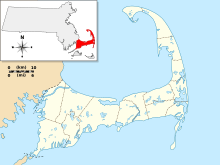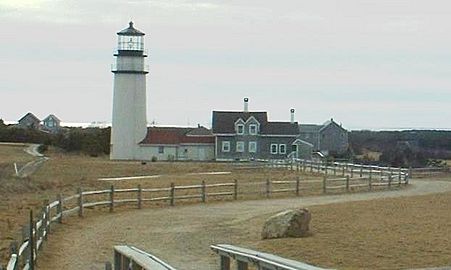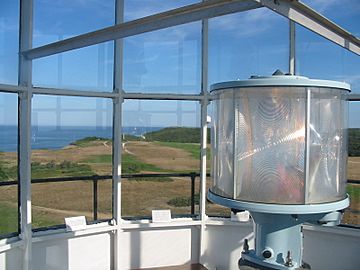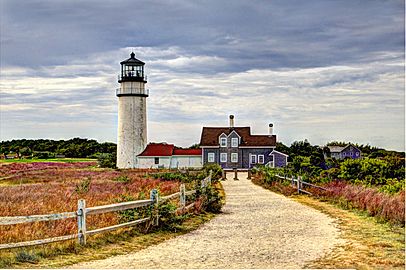Highland Light facts for kids
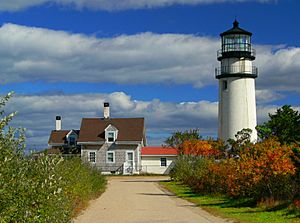 |
|
|
|
|
| Location | North Truro, Massachusetts |
|---|---|
| Coordinates | 42°2′22.282″N 70°3′39.377″W / 42.03952278°N 70.06093806°W |
| Year first constructed | 1797 |
| Year first lit | 1857 (current structure) |
| Automated | 1987 |
| Foundation | Natural/emplaced |
| Construction | Brick |
| Tower shape | Conical |
| Markings / pattern | White with black lantern |
| Height | 66 feet (20 m) |
| Focal height | 170 feet (52 m) |
| Original lens | 1st order Fresnel lens |
| Current lens | VegaMarine LED Beacon |
| Range | 18 nautical miles (33 km; 21 mi) |
| Characteristic | Fl W 5s, lighted continuously |
| Fog signal | none |
| Admiralty number | J0390 |
| ARLHS number | USA-110 |
| USCG number | 1-500 |
The Highland Light (also called Cape Cod Light) is a working lighthouse located in North Truro, Massachusetts, on the Cape Cod National Seashore. The lighthouse you see today was built in 1857. Before that, there were two other towers built in 1797 and 1831. It's the oldest and tallest lighthouse on Cape Cod!
You can visit the lighthouse grounds all year. The light itself is open to the public from May to late October, and you can even take a guided tour. The National Park Service owns Highland Light. A group called Eastern National helps run it as a place for tourists to visit. The United States Coast Guard still uses the light to help ships find their way. A United States Navy ship, the USS Highland Light (IX-48), was named after this lighthouse. It is also listed on the National Register of Historic Places as the Highland Light Station.
Contents
History of Highland Light
Early Lighthouses
In 1797, George Washington approved building a lighthouse at this spot on Cape Cod. It was made of wood. Its job was to warn ships about the dangerous coastline between Cape Ann and Nantucket. This was the very first lighthouse on Cape Cod.
In 1833, the wooden lighthouse was replaced with a new one made of brick. Then, in 1840, it got a new lantern and lighting system.
The Current Tower
By 1857, the brick lighthouse was considered unsafe. So, it was torn down. For about $17,000, the current 66-foot brick tower was built. This is the lighthouse you see today.
Lighting Up the Coast
On June 6, 1900, the light changed from a steady beam to a flashing one. A new, powerful Fresnel lens was installed. This lens was very bright and flashed every five seconds. While the new lens was being put in, a temporary light was used.
The Highland Light became the most powerful lighthouse on the East Coast of the United States. It also got new oil engines to make sure the fog signal could start working quickly, in just ten minutes. In 1929, an electric fog signal was added to make it heard even farther away.
Modern Changes
In 1932, the lighthouse started using electricity with a bright 1000-watt beacon. Later, in 1946, the old Fresnel lens was replaced with modern lights. Sadly, the Fresnel lens was broken when it was removed. You can still see pieces of it at the museum there.
By 1986, the lighthouse was fully automated, meaning it ran by itself. In 1998, a different optical system was put in. Most recently, in April 2017, the light source was updated to a modern LED beacon.
Moving the Lighthouse
The lighthouse you see today is not in its original spot! It was in danger of falling off the cliff because the beach was eroding. So, in 1996, the entire lighthouse was moved about 450 feet (137 meters) to the west.
This big move took 18 days in July 1996. Money for the move came from the government and from fundraising by the Truro Historical Society. After the move, the lighthouse was still on the Cape Cod National Seashore property, right next to the Highland Golf Course. Once, a golf ball broke a window, so they replaced them with unbreakable material!
In 1998, the keeper's house (where the lighthouse keeper used to live) was changed into a gift shop and museum. You can visit the lighthouse grounds all year. During the summer, you can take tours and visit the museum.
-
1959 photo from the Historic American Buildings Survey Collection, Library of Congress
Highland Light in Art
The famous painter Edward Hopper owned a summer house in Truro. He painted this lighthouse in his work called Highland Light, North Truro (1930). Even though the lighthouse was moved later, the landscape in the painting still looks a lot like the area around the lighthouse today. This watercolor painting is now at the Harvard Art Museums.


